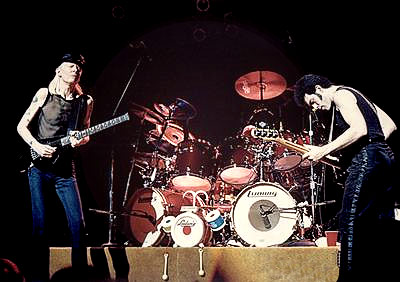DIE EINSAMKEIT DES BLUES STEIGERT ALBINO WINTER BIS ZUM INFERNALISCHEN GITARREN-FEUERWERK. DER MANN UND SEINE GITARRE ERZEUGEN IMMER NOCH DAS PURE GEFÜHL, HAUCHEN AUCH AUSGELAUGTEN BLUES-STANDARDS IMMER WIEDER NEUES LEBEN EIN.
Die Frage, ob Weiße den Blues spielen können, ist ebenso alt wie langweilig. Johnny Winter, einst eines der größten Idole des Blues-Rock, dürfte diese Problematik nie einen Deut geschert haben, sonst würde er heute nicht mehr auf Tournee gehen und so brettharte Konzerte hinlegen wie jüngst in der "Großen Freiheit". Mit dem Album *WINTER OF '88* hatte er sich studiotechnisch vollwertig zurückgemeldet, und eigentlich konnte live auch nichts schiefgehen, denn seit Jahren sind er und seine beiden Compadres Jon Paris (b) und Tom Compton (dr) unterwegs, höchstwahrscheinlich um den Rekord im Dauer-Touren zu brechen.
Umso sympathischer, dass die drei trotzdem keine seelenlose Routine-Band sind, denn immerhin benötigen Winter & Band gut und gerne eine halbe Stunde, um sich warm zu spielen. Sachte, aber unaufhaltsam, wie ein riesiger Lastwagen, der auf große Fahrt geht, kam Johnny Winter auf den Siedepunkt, und spätestens nachdem er seine abgrundhässliche Gitarre gegen eine ordentliche vertauscht hatte, bretzelte er so los, wie man es von ihm schon lange nicht mehr gehört hatte. Schneidend, jede Note ein Blitzstrahl, gestochen scharfe Melodielinien, die sich im nächsten Augenblick zu Akkorden ballen und wie große Feuerräder aus den Boxen kullern – seltsam, es ist also doch noch möglich, mit Virtuosität heiße, pure Faszination zu erzeugen.
Während sich Winter taumelnd, krähend und in den Hüften federnd von einem Break zum nächsten hangelt, passt Jon Paris genau auf, dass alles klappt und kramt zur Steigerung auch mal die Mundharmonika hervor. Der heimliche Zeremonien-Meister? Nein, der sitzt hinterm Schlagzeug. Tom Compton spielt wie „Das Tier“ aus der Muppet-Show, ein wiedergeborener Keith Moon, unglaublich präzise und präsent. Ein ZZ-Top-Feeling bar jeder Brutalität, ein fließendes Inferno organischer Drum-Disziplin. Selten, sowas.
Je mehr ihr Set fortschritt, umso dichter und kochender wurde die Musik der Winter-Band. Und zu keiner Sekunde fiel störend auf, dass der texanische Flinkfinger eigentlich nur Standards spielte, von wenigen eigenen Songs wie "Hustling Down in Texas" mal abgesehen. Ein Interpret – aber einer mit ganz eigenen, unvergleichlichen Maßstäben.
Dieses Feuerwerk an solider, schnurgerader Spielfreude hätte gern etwas länger dauern dürfen als die kargen 70 Minuten, aber was soll's: Es gibt wenig Konzerte dieser Art, die man in besserer Erinnerung behält.
WERNER THEURICH











